Lincolnshire
EPWORTH
But for the arrival of a certain rector in 1696, few would have heard of this unremarkable place, set in flat fenland country. The new rector, Samuel Wesley, came with his accomplished wife Susannah and his large and still growing family. The conversion and labours of their sons John and Charles would mean that Epworth is forever remembered as the spiritual home of worldwide Methodism. Today there is a well-signposted Wesley Trail to all places of interest.

Epworth Old Rectory
We start at Epworth Old Rectory (DN9 1HX). This is not the house in which the Wesley children were born for that was destroyed in the historic fire of February 9th 1709. The family were asleep at the time, but miraculously all survived. Five-year-old John was the last to be rescued, snatched from an upstairs window by one man standing on the shoulders of another just as the roof fell in. He ascribed this deliverance to divine intervention, and described himself thereafter as a brand plucked from the burning. On the road close to the Old Rectory, a statue of John Wesley was unveiled in 2003 to mark the three hundredth anniversary of his birth.
The handsome three-storey house with its peaceful garden stands on the site of the former thatched rectory and, after months of temporary accommodation, the Wesley family moved back in. Since 1954 it has been owned by the Methodist church and has many items relating to its famous former occupants - family furniture, books, portraits and letters. There are several prints of events in the lives of the Wesley brothers which have become part of the folklore of Methodism - John's rescue from the fire, Charles meeting native Americans in Georgia, John preaching on his father's tomb and being attacked by a mob in Wednesbury. In one room the signatures of several family members, made in wet plaster, are preserved.
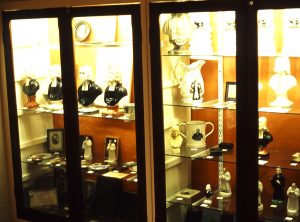
Wesley memorabilia
Around 1716, unexplained noises and events - witnessed by several people - suggested that the new rectory had a ghost. The robust Samuel ignored advice that he should move out, declaring that the devil must flee from him, not the other way round. The Wesley children seemed unconcerned and nicknamed the ghost "Old Jeffrey". The attic room at the top of the house is known as Old Jeffrey's Chamber and displays items of Wesley memorabilia.
Samuel Wesley was not always a good father, sometimes absent from home for months on end, and at one time confined in the debtors' prison in Lincoln. The remarkable Susannah was frequently left with little money to bring up the family alone. The rector, however, was no mean scholar, producing works of theology including a long commentary on the book of Job. He even contemplated founding a missionary society to take the gospel to India and China at a time when few gave any thought to such matters. On his deathbed in 1735, he said prophetically to Charles The Christian faith will surely revive in this kingdom; you shall see it, though I shall not.
Perhaps the most significant room in the house is Susannah's parlour, where she would gather her children around her for Bible study, prayer and instruction. During one of Samuel's long absences, she also extended her teaching to some local villagers who were not impressed by the ministry of the curate. This earned a rebuke from her husband who wrote that she should not undermine the curate's authority. A characteristically robust reply from Susannah is preserved, in which she argued that the spiritual welfare of the parishioners was of more importance than the niceties of church politics.

Samuel Wesley's grave
St Andrew's Church, approached through an avenue of sycamore and lime, has recently undergone a major program of restoration (DN9 1ES). Here we can see the font where the Wesley children were baptised and a chair donated by Susannah Wesley is kept in the sanctuary. Display boards give details of the Wesley family and describe the social conditions of people in the Epworth area in the eighteenth century.
Samuel Wesley is buried in the churchyard and his raised tomb with its wrought-iron surround lies near the east end of the church. The relationship between the church and the subsequent ministry of John and Charles was not always amicable. When, four years after his dramatic experience in Aldersgate Street, John Wesley returned to Epworth in 1742, he found the church locked against him by the new rector. So he stood on his father's tomb and preached in the churchyard to such a congregation as I believe Epworth never saw before. After another week of preaching to large crowds around Epworth, he reflected Nearly forty years did my father labour here, but he saw little fruit of his labour.... but now the fruit has appeared. The epitaph on Samuel's tomb has been much eroded by others standing on it in imitation of Wesley, but is recorded on a display board nearby.
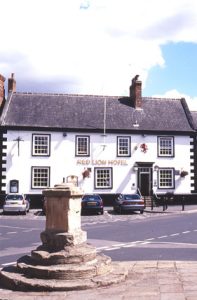
Red Lion & Market Cross
The Wesley Memorial Methodist Church in the High Street (DN9 1EP) was built in 1888 and has that confident look of a late Victorian non-conformist church complete with spire and stained glass. Records of the early Methodist societies are preserved here, and above the pulpit is a window with roundel portraits of the brothers and John Wesley's deathbed quote The best of all is God is with us. There are framed prints of incidents in his life and a marble tablet on the wall gives further biographical details. The font is inscribed in memory of Susannah.
In 1724, John Wesley returned to Epworth for two years to serve as his father's curate and was responsible for the tiny hamlet of Wroot, five miles west of Epworth, which was often accessible only by boat. Following Samuel's death, the Wesley family had to leave Epworth and on subsequent visits John would usually stay at the Red Lion Hotel, which is still open for business. Immediately opposite are the remains of the old Market Cross, from whose steps he preached on several occasions.
GAINSBOROUGH
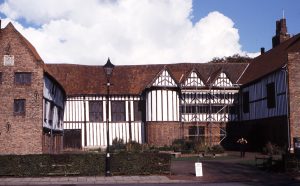
Gainsborough Old Hall
The town lies on a navigable section of the Trent and faces two enormous power stations across the river. While much of Gainsborough is architecturally undistinguished, it has one great treasure - the Old Hall - on Cobden Street near the town centre (DN21 2NB). Shaped like a large letter E, but without the middle stroke, it was built for Sir Thomas Burgh between 1460 and 1490. The central part is timbered, with the wings mainly of brick.
In 1596, the Hall was purchased by William Hickman, a London merchant with strong Protestant convictions and sympathetic to the separatist position. At about the time that Richard Clifton's separatist church began meeting in William Brewster's house at Scrooby in Nottinghamshire, the Hickman family allowed another group, led by John Smyth, to meet in the Old Hall. A link between the two congregations was provided by John Robinson (1576-1625), who was probably born at Sturton-le-Steeple, a few miles away across the Trent.
In the early days of the Gainsborough congregation, John Robinson provided pastoral support to Smyth, but later joined Clifton as teacher of the Scrooby church. Robinson had attended Cambridge University and served for a time as lecturer in St Andrew's church in Norwich. In about 1608, under threat from the church authorities, both congregations moved to Amsterdam, but relations between them were not always harmonious. Smyth frequently changed his opinions and was involved in disputes with Robinson and Clifton. Eventually Smyth was expelled from the English church, and many of his congregation joined the Dutch Mennonites. For this reason, the eventual roll call of those who sailed on the Mayflower in 1620 included relatively few from the Gainsborough area. Smyth had died in 1612 and Clifton in 1616. Although recognised as their spiritual leader, Robinson did not sail on the historic voyage. The reason is unclear; he may have intended to join them later or he may have felt a pastoral concern for church members who had chosen to remain in England. However, Robinson's sister-in-law Catherine Carver sailed as wife of John Carver, the first Governor of the Plymouth colony.
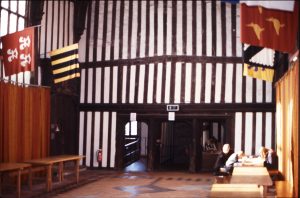
Old Hall interior
By the mid-eighteenth century, the Old Hall had seen better days and was being used as a workshop by carpenters, coopers and plumbers. However, it still provided a useful meeting place. Travelling to and from Epworth, John Wesley frequently passed this way and preached in the Great Hall in 1759, 1761 and 1764.
Not far from the Old Hall, on the corner of Church Street and Gladstone Street is the United Reformed John Robinson Memorial Church (DN21 2JR) opened in 1896. A stone in memory of John Robinson, pastor and exile was laid by T. F. Bayard, the American ambassador of the day. This church now hosts an excellent exhibition telling the story of the Pilgrim Fathers and their connection to the town of Gainsborough.
BOSTON
Despite lying several miles inland, Boston is connected to the sea by a channel called the Haven and visitors may be surprised to find it is still a port town with docks and cranes. The town takes its name from St Botolph, a monk who founded churches in these parts in Saxon times.
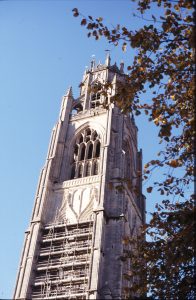
Boston Stump
Rising high above the landscape, 272 feet to be precise, is the tower of St Botolph's Church (PE21 6NW), known locally as the Boston Stump, which has served as a beacon to travellers by land and sea for centuries. More on the scale of a cathedral, the church is one of the glories of Lincolnshire and a triumph of medieval engineering. It is the largest building in England that has always been a parish church.
It was from Boston that the separatist congregation from Scrooby, some of whom were destined to become the Pilgrim Fathers, attempted to escape to Holland in 1607. They had embarked on a ship, but were betrayed by the captain. A monument at Scotia Creek on the Haven commemorates the event. The men, including Richard Clifton, William Brewster and John Robinson were arrested, stripped of their possessions and imprisoned. They spent several weeks incarcerated in cells below the Guildhall, which now houses the Guildhall Museum in South Street. The cells where the future Pilgrims were held can still be seen. Despite this setback, they managed to reach Holland the following year.
Some four years later, while the Scrooby separatists were considering their options in Holland, a new vicar arrived at St Botolph's church. He was John Cotton (1584-1652), who, with his congregation, would take the name of Boston to Massachusetts. Cotton came here in 1612, but his puritan sympathies brought him into conflict with the church authorities. In 1630, ten years after the Pilgrim Fathers had sailed, several from his church departed for New England. Cotton was ill at the time, but joined them in 1633, accompanied by fellow puritan Thomas Hooker.
The Cotton Chapel in the south aisle was restored in 1857 as a memorial to Cotton, with financial support from transatlantic Bostonians. The arms of the Cotton family are shown on one of the corbels. Apparently the architect intended to paint the ceiling with stars and stripes but was dissuaded by the vicar!
On the north side is a twentieth century stained glass window, showing John Cotton bidding farewell to members of his flock as they leave for the New World on the ship Arbella in 1630. Ironically, another panel in the same window celebrates Archbishop William Laud, who ordered the restoration of the St Botolph's and founded its library shortly after Cotton's departure. It was Laud's attempts to introduce high church practices that angered the puritans and prompted many to leave for America.
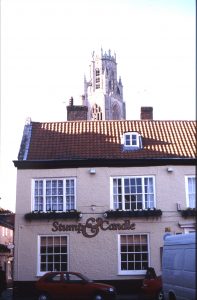
John Foxe's birthplace
In the area under the tower is a memorial to the Pilgrim Fathers and a model of the Mayflower. However, it is not just Americans who come here to celebrate their heritage. Three pioneers in the exploration of Australia - George Bass, Matthew Flinders and Sir Joseph Banks - all had links with the town and are commemorated on a tablet.
In the older part of Boston by the Market Place is a pub now called the Stump and Candle (formerly the Rum Puncheon Inn). This was the birthplace of the martyrologist John Foxe (1516-1587), whose Acts and Monuments, first published in 1563, described in graphic detail the suffering and execution of Protestants in Queen Mary's reign. For over two centuries, Foxe's Book of Martyrs, as it became known, was required reading in many English households and often their only book apart from the Bible.
IMMINGHAM
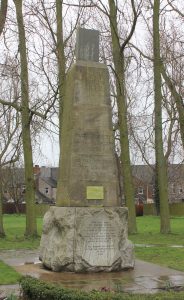
Pilgrim Fathers memorial
Immingham is not a natural tourist destination. Lying on the south side of the Humber estuary, it mainly features an industrial complex of docks, factories, chemical works and power stations. However, those on a Pilgrim Fathers pilgrimage may choose to pay a brief visit.
In the residential part of the town, in Church Lane opposite St Andrew's Church (DN40 2RH), is an area of grass like a village green with an imposing memorial to mark the departure of the Scrooby congregation for Holland in 1608. The topstone is a piece of granite from Plymouth, Massachusetts. In 1607 they had been detained and stripped of their valuables while trying to leave from Boston, but the following year, despite various mishaps and adventures, they made a successful escape from Stallingborough Haven, off Laporte Road.
FILLINGHAM
John Wycliffe served as rector of St Andrew's Church from 1361 to 1368, but may not have spent much time in the parish. He is included in the list of former rectors on a panel in the church. The church was largely rebuilt in 1777, but the doorway and arches date back to Wycliffe's time.
STAMFORD

Alll Saints church
Stamford was formerly a major coaching stop on the Great North Road. Historic inns like the George Hotel recall its past, while on the busy A1 nearby, juggernaut lorries have replaced the Edinburgh stagecoach. The whole town is built from honey-coloured limestone.
Links with the eccentric and irascible Robert Browne (1550-1631) bring us here. He came from a wealthy Stamford wool family and his ancestors, brothers William and John Browne, built All Saints Church in Red Lion Square (PE9 2 AG). William also founded Browne's Hospital in Broad Street in 1483. The brothers and many of their relatives are buried in the church and in the north aisle are memorial brasses to several members of the family, some with woolsacks at their feet to indicate the source of their wealth, but there is no mention of Robert.

Browne family brasses
Browne was born at Tolethorpe, near Little Casterton, just north of Stamford. Known as "Troublechurch Browne", he was an early advocate of "separatism" and is regarded by some as the founder of the Congregational church. He was frequently imprisoned for advocating independent church government and men were hanged for printing or distributing his books. His followers, known as Brownists, even get a negative mention in Shakespeare's Twelfth Night.
For a time he ministered to a congregation in Norwich, but official disapproval led the whole company to seek refuge in Holland. After signing a pledge not to disturb the peace, Browne returned to become headmaster of the grammar school in Stamford. Five years later he became vicar of Achurch in Northamptonshire where he served, more or less peacefully, for forty years. Alas, it was too good to last. By now in his eighties, he struck a constable in a fit of rage over taxes and was taken to Northampton gaol where he died. As one writer noted, it was strange that the Congregationalists should trace their origins to so eccentric a man.


